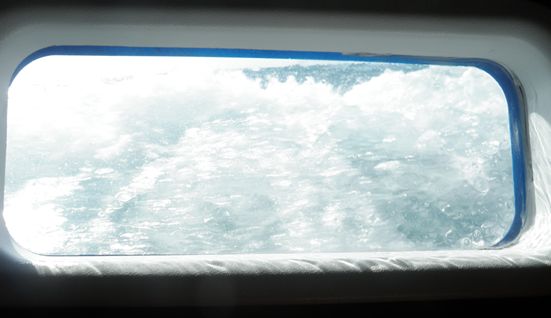The Arafura Sea and Gulf of Carpentaria 10 54S 133 04E

|
15th – 19th June 2011 To get to Darwin we have to cross the Gulf of Carpentaria, a bit like an Australian Bay of Biscay but shallow and full of tides which can push us on or drag on us so that progress slows down. The shallow seas and the powerful tides make for big erratic white-capped waves which lunge at the boat and push us sideways toward Papua New Guinea. Through the port-hole – the wave is coming at us side on..............
.........................and here it is!
When we started the water was a pale milky turquoise, its now grey or deeper blue depending on the sun. Progress is good, we only do less than 6 knots when the current is against us, often we are getting over 7 knots, we have had good to strong winds on the whole with about half a day of wimpish stuff but we have managed to avoid motoring.
The western half of Carpentaria is in Queensland, the only state we have sailed in so far. The other half belongs to the Northern Territory which includes Arnhem Land and numerous islands, all vast Aboriginal Settlement Areas. In the past, before crocodile hunting was banned this is where a lot of it happened, we have sailed past islands and reefs named after these prehistoric creatures which preceded the dinosaurs. The other major activity was prawn fishing for banana prawns which are here in great abundance, this still goes on but to a lesser extent. Most of the prawn fishing in Queensland is done at night but the banana prawns can be netted during the day giving the fishermen a more normal lifestyle. The main business in the Gulf now is strip mining for bauxite, the raw material for Aluminium, discovered in the1950s by an Australian geologist. The mining of bauxite is now a major contributor to the Australian economy. We've seen no sign of it as it happens well into the bay.
There has been little to see, two ships and birds. The dratted gannets are coming to the boat at night again, there must be some air flows created by the sails which enable them to rest. We do admire these super efficient birds and they are fabulous to watch but their capacity for covering the boat in gannet shat is exasperating. We have only just got the last of it off the sails from our previous lot of visitors, it is really unpleasant, black and oily – just to share the experience! As we closed the coast of the Gulf on its eastern side we left Papua New Guinea to the North East and are now south of the first scattered islands of Indonesia. To the north is Saumlaki where some of the boats involved in the Indonesian Rally will be going. We don't want to go back this way so shall be going north from Darwin to Kupang on east Timor which from here is still a way to our north west. We should be there in late July. We had one minor emergency on Chris's early hours watch when the genoa suddenly decided to come down and ended up in the water. After retrieving it, it transpired that the shackle had parted on the halyard swivel leaving the halyard and swivel at the top of the mast. We could re-hoist the genoa but we would be unable to furl it. In the winds we have had of 25 knots plus it would be much too big but fortunately we have a small sail of less than half the area of the genoa. We bought this small but perfect head-sail in 2008 at the Beaulieu Boat Jumble for £10, we have used it frequently for downwind goose-winged sailing, it works a treat. It is currently paying us back handsomely by pulling hard for Darwin! Once across the Gulf of Carpentaria to the Grove peninsula we thought to anchor for the night in the lee of a string of slim islands shooting spear-like northwards from the headland. The genoa could have been fixed there but sailing Sod's Law had us passing this island chain at 03:00 a.m. and despite a good moon, with no charted anchorages we didn't want to risk it, so on we go. The weather forecast today advised that winds would be dropping, it hasn't happened yet, we are charging along at 7.5 to 8.5 knots at the moment; if this keeps up we shall be arriving in Darwin in less than two days. Meanwhile, in about 8 hours we shall be passing New Year Island and Hogmanay Shoal, sounds rather fun. We have another 94 miles on this leg of our route to Cape Croker, there we change course and start moving WSW along the Cobourg Peninsula before making more south through the Dundas Strait and down into Van Diemen Gulf which looks fantastic on the chart. This giant basin 95 x 56 miles is created by a deep bay blocked from the sea by the mighty Melville and Bathurst Islands. It is therefore well protected and rarely more than 20 metres deep with plenty of reefs and shoals. Here we take Gryphon WSW again, crossing the Gulf to the south west gap where we channel our way through the reefs between Melville Island and the mainland to get out into the Clarence Strait ready to turn south for the 20 mile run down to Darwin. We wonder what it will be like, in Fiji we met a motor yachtie, off to Hawaii then up to the Arctic circle, who said it would be unbearably hot. So far, despite having sailed up from Cairns through 6 degrees of latitude nearer to the equator, it is just pleasant during the day and rather cool at night, definitely not unbearable yet. |

